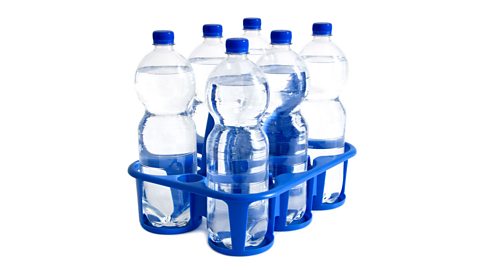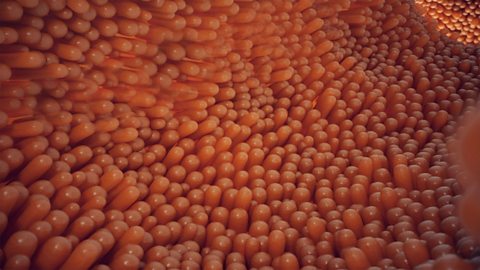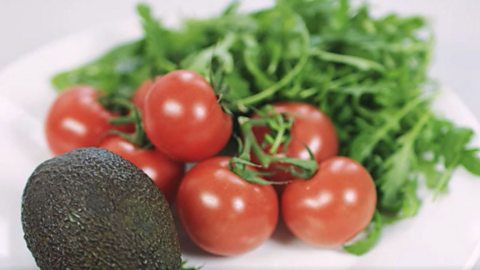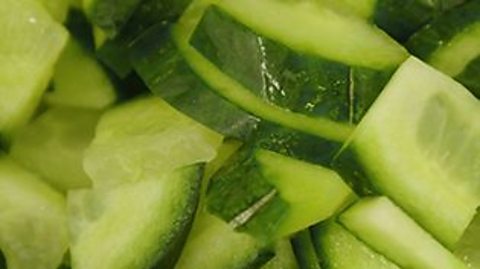Key points
- The digestive system breaks down food into tiny particles which are absorbed into the blood.
- These particles provide energy for the body to grow, repair itself and remain healthy.
- Food that cannot be broken down is released from the body as faeces (poo).
Digestive system activity
Play this game to explore how food is processed by the human body.
Parts of the digestive system
The digestive system is made up of key parts, each of which has a different function. Food passes through most of these parts in a journey from the mouth to the anus.
| Part of the digestive system | Function |
|---|---|
| Mouth | Digestion of food starts in the mouth. Teeth break down the food and mix it with the enzymesBiological molecules called catalysts which speed up reactions, including digestion. in saliva. |
| Oseophagus | This is a thin tube that connects the mouth to the stomach. |
| Liver | This releases a chemical called bile into the intestines. Bile breaks down lipidsFats and oils. Fats are solid at room temperature whilst oils are liquid. in the food. |
| Stomach | This is a muscular bag which mixes food and drink with acid. |
| Pancreas | This releases enzymes into the intestines which break down carbohydrates, protein and lipids in food. |
| Small intestine | Here, carbohydrates These are mainly sugar and starches which provide your body with energy. Foods like bread, pasta, rice and potatoes contain lots of carbohydrates. protein A food group used for growth and repair. Foods like meat, fish, eggs and dairy products contain lots of protein. and lipids digest. The nutrients produced are then absorbed into the blood. |
| Large intestine | Food which cannot be broken down - mainly fibreA food group that cannot be broken down in the digestive system . Foods like cereals, pasta, bread, fruits and vegetables are high in fibre. - passes into the large intestine. Water is absorbed into the blood. |
| Rectum | Any undigested food passes into the rectum where it is stored as faeces. |
| Anus | This is the opening at the very end of the digestive system through which faeces leaves the body. |

Did you know?
Your mouth produces about 1.5 litres of saliva each day.

Video - Modelling the digestive system
How to model digestion using tights
This one is going to get a little gross.
For now, you'll need a clear plastic bag, make sure there are no holes or this could get even messier, orange juice and water, biscuits and a banana, a bowl, a tea towel, and one leg of a pair of tights. But make sure you ask before you take it, nobody wants to wear one-legged tights.
Put your food, water, and orange juice in the stomach. No, not that one. In the plastic bag stomach.
Now get digesting. Give it a good squeeze and mush the food with the water and acidic orange juice, just like the stomach acid does to the food in your stomach. Transfer the food to the tights, that's the small intestine.
Squeeze out the remaining liquid. This is all the nutrients your body needs to function properly and collect it all up in the bowl. Squash all the remaining moisture and nutrients out using the tea towel, just like the large intestine does.
Well, okay, the large intestine doesn't use a tea towel, but it does absorb moisture and nutrients from the food.
Cut a small hole in the end of the tights and squeeze out the remaining undigested food. And yes, that is exactly what it looks like, the results of the digestive system, poo.
And that's that, you've modelled digestion from the stomach to the toilet.
Who's hungry?
1. In the model, what does the plastic bag represent and why is the food squeezed into it?
2. In the model, what represents the large intestine and why?
It represents the stomach where food is churned up.
A tea towel because it absorbs water.
Process of digestion
Mechanical and chemical digestion
Teeth break down food in the mouth mechanically, this means they grind it up. Chemical digestion occurs when enzymes digest food into nutrients.
Bile is produced by your liver and stored in the gall bladder. This is released into the small intestine to break down large molecules of lipids into smaller ones. This is not digestion because it doesn’t break down lipids into nutrients, just smaller droplets. This is called emulsificationThe breakdown of large drops of lipid into smaller droplets. and increases the surface area for enzymes to act upon.
Moving food through the digestive system
Digested food is moved through the oesophagus, and small and large intestines by muscles in their linings that squeeze it along in a process called peristalsisThe rhythmical contraction of muscles lining the oesophagus, and small and large intestines to squeeze food through them. Squeezing a tennis ball through a pair of tights is a good model for this process.
Absorbing food and water

The intestines have lots of tiny folds in them which create a large surface area for absorbing nutrients and water. In the small intestine there are also specialised structures called villi which have a tiny hair-like structure poking into the small intestine to absorb digested food.


Did you know?
If we stretched out all the folds in the small intestine this would be the area of a tennis court.

Test your knowledge
Quiz - Digestive system
Test questions
1. Put the parts of the digestive system in the order that food travels through them.
- a. oesophagus
- b. stomach
- c. anus
- d. large intestine
- e. rectum
- f. mouth
- g. small intestine
2. Match the parts of the digestive system in the list to their function.
- Where food that cannot be digested passes into before becoming poo
- Connects your mouth to your stomach
- The opening at the end of the digestive system; faeces pass out of the body here
- Faeces is stored here
- A muscular bag that mixes food and drink with acid
- Where nutrients are absorbed into your blood
- Mechanical and chemical digestion starts here
- f. mouth
- a. oesophagus
- b. stomach
- g. small intestine
- d. large intestine
- e. rectum
- c. anus.
- Mouth: mechanical and chemical digestion starts here
- Oesophagus: connects your mouth to your stomach
- Stomach: a muscular bag that mixes food and drink with acid
- Small intestine: where nutrients are absorbed into your blood
- Large intestine: where food that cannot be digested passes into before becoming poo
- Rectum: faeces is stored here
- Anus: the opening at the end of the digestive system; faeces pass out of the body here.
Teaching resources
Are you a teacher looking for more resources? In this collection of biology clips, doctor and presenter Chris van Tulleken introduces videos from the ґуПуґ«ГЅ archive for use in the classroom.
ґуПуґ«ГЅ Teach has thousands of free, curriculum-linked resources to help deliver lessons - all arranged by subject and age group.
Play the Atomic Labs game! gamePlay the Atomic Labs game!
Try out practical experiments in this KS3 science game.

More on Nutrition, digestion and excretion
Find out more by working through a topic
- count2 of 15

- count3 of 15

- count4 of 15

- count5 of 15
